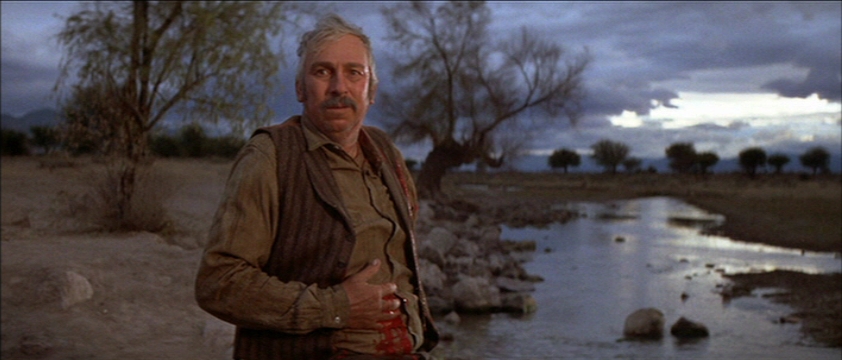 I grew up in the era when Westerns dominated television. In 1960, virtually half of the primetime programs were some type of Western. And they were trite, repetitive, lacking in action and often in purpose. The economics of television at the time made actual action scenes difficult and rare--Westerns were distinguished by people in big hats and boots and every once in a while they went outside and got on a horse that was tied up out front. Few of them bore the elements that make the Western the great form that film writers and cineastes are able to analyze and celebrate over and over.
I grew up in the era when Westerns dominated television. In 1960, virtually half of the primetime programs were some type of Western. And they were trite, repetitive, lacking in action and often in purpose. The economics of television at the time made actual action scenes difficult and rare--Westerns were distinguished by people in big hats and boots and every once in a while they went outside and got on a horse that was tied up out front. Few of them bore the elements that make the Western the great form that film writers and cineastes are able to analyze and celebrate over and over.So having suffered many pale carbons of the Western form, I had to learn to love Westerns. Luckily for me, a college classmate insisted I come with him to sit in on a professor who was showing The Searchers, stopping it over and over to pick it apart and illuminate its greatness. I had never even heard of the film. In those days, John Ford was considered a great director because of The Informer, The Grapes of Wrath and How Green Was My Valley, those mainstream Academy-bait pictures. True, my dad loved to watch the cavalry pictures on a Sunday afternoon, especially when they all got on their horses and began singing. (Real men were unafraid of singing back in those days.) So this screening of The Searchers was a real eye-opener. I began to appreciate and understand both the visual poetry and the narrative tropes of the Western.
Today a lot of the ideas that sustained Westerns have been completely absorbed into sci-fi. Avatar is the best example of this, being a flat-out reworking of the white-man-who-becomes-a-better-Indian-than-the-Indians trope one finds in A Man Called Horse, Dances With Wolves and the like. But I still love the look of the Western, and the taciturnity of the best ones.
Still, I have never "gotten" the Peckinpah cult. His first Western, Ride The High Country is one of my favorites and an all-time great, an example of the end-of-the-West genre. Peckinpah continued to work this vein, but decided that instead of quick, bloodless death, which deny the consequences of the violence of the genre, he would have long, drawn-out, slow-motion and very bloody death. When films such as The Wild Bunch appeared, critics wrote verbal rhapsodies about Peckinpah's "poetry of violence."
Except that Peckinpah's so-called poetry was just as phony as the fall-down-you're-dead fake violence that had preceded it. Blood does not fly out of bodies the way it does out of stage-blood packs and stuntmen do not look graceful flying around in slow motion. I'm reminded of the egregious slow-motion sequence in Easter Parade which reveals that Fred Astaire, so effortlessly graceful in standard speed, looks clumsy and ungainly slowed down--that his "grace" is an illusion as convincing as a fine stage magician's (which is what Astaire was). Real violence is usually sudden and all the more brutal because of that. A soul has departed the earth before anyone, including the victim, had even a moment to contemplate what that meant.
Pat Garrett and Billy The Kid (1973) was meant to be a contemporary interpretation of the old legend of the lawman who must kill his former friend. With fine actors, especially ones who had been friends, such as Henry Fonda and Jimmy Stewart for instance, you might have had a fine movie. But neither James Coburn or Kris Kristofferson bother to do anything than pronounce the rather pedestrian lines in the script, and the story is utterly without resonance or significance. If you go by this film, people in the Old West would shoot each other just to cover an awkward pause in the conversation. As in most Peckinpah films, it is phony from beginning to end.
I should clarify "phony." I don't mean artificial. All art employs artifice. Ford, Hawks, all the greats rework myth and engage in artifice. We are not talking documentary. By "phony" I mean behaviors and story beats that do not resemble recognizable human behavior. Usually they are simply tropes repeated from other stories--art twice removed from life--meta-art that is about nothing but the creation of art. In other words, pretension squared.
There is one moment of exquisite poetry in Pat Garrett, and it is one place in which I wish the long-winded Peckinpah had lingered even longer. The beloved Slim Pickens and Katy Jurado appear as a bounty-hunting couple and it is a delight to see their now-weathered but familiar faces. (The film is filled with wonderful traditional Western actors who were probably surprised to learn what a dull film they had become part of.) Minutes within their arrival in the film, Pickens is fatally shot in the gut (see the illustration above). To the mesmerizing "Knockin' On Heaven's Door" by Bob Dylan (written for this film), Jurado and Pickens exchange farewell glances that speak volumes about their long life together, their abiding affection and the pain of this terrible parting. (Check out this clip.)
For once, Peckinpah admitted actual humans into the film and it almost rips its synthetic texture apart. Now that's poetry.





No comments:
Post a Comment